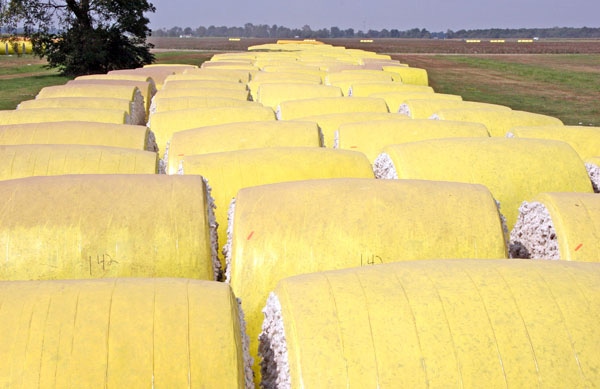
USDA bumped its estimate of world ending stocks for 2012-13 to a record 76.5 million bales in September.That's enough cotton to supply 71 percent of the world's needs in 2013-14.Cotton analysts believe the cotton market will hold steady, and advise producers to price cotton on rallies that may occur next spring.

Thoughts of dollar cotton seem like a distant dream these days, and for good reason, too. China is estimated to have enough cotton in its strategic reserve to serve most of its domestic consumption needs for 2013. Grain and soybean prices have gone through the roof. Not only is cotton acreage shrinking next year. It needs to.
It all begins with that big number in the world ending stocks column, notes John Robinson, Extension economist, Texas A&M University, speaking at the Ag Market Network’s September conference call.
Those numbers reflected in USDA’s decidedly bearish Sept. 12 estimates of world cotton supply and demand were telling. Beginning stocks were increased for Australia by 300,000 bales, for India, 400,000 bales and for China, 1.3 million bales. “It just adds more weight to the supply side which is going to ultimately burden the ending stocks number.”
Meanwhile Indian cotton production was raised by 1 million bales compared to August, but USDA offset much of that with reductions in Brazil and the United States.
Rain delays harvest of Mid-South cotton crop
“The bottom line from all of these adjustments factors out to increasing supply, decreasing consumption and another move to record world ending stocks, at 76.5 million bales,” Robinson said.
“The world stocks-to-use ratio is now 71 percent. What that means is that when we get to the end of this marketing year, 71 percent of the cotton that the world needs in the 2013-14 marketing year is already in hand, in a warehouse. It’s just a picture of excess supply.”
U.S. numbers tell a different story. USDA adjusted its estimates for U.S. planted and harvested acres – 275,000 fewer acres planted and 375,000 fewer acres harvested. It bumped abandonment by 1.5 percent and raised estimated U.S. cotton yield slightly. Robinson believes further adjustments to harvested acres will come in future USDA reports, particularly in the dryland areas of Texas.
The adjustments in U.S. acres resulted in a little over a 500,000 bale decrease in production, which was partially offset by raising ending stocks 50,000 bales and lowering U.S. exports by 300,000 bales. “So the bottom line was that we got a little bit tighter ending stocks, by about 200,000 bales.”
While that could be price bullish to price neutral, U.S. fundamentals continue to be swallowed up the bearish world numbers, Robinson said. USDA shrunk the range on the projected farm price to 65 cents to 78 cents a pound.
Robinson noted that 2013 cotton futures are trading at a few cents over 2012, after being inverted much of the early spring. “That is suggesting that the fundamentals for 2013 might be the same as what we have now, or maybe just a little bit better,” Robinson said.
Cotton bales rolling out of Bobo-Moseley Gin — photos
Acreage reductions could be significant, here and around the world Robinson said. “We're going to begin to see it this coming November, when we see what is being planted in the Southern Hemisphere, in Australia, Brazil, and Argentina.”
Acreage cuts in the Mid-South and Southeast are expected to be heavy, and there has been aggressive forward contracting in corn and soybeans. “In the Southwest, I’ve been hearing about strong cash bids on grain sorghum,” Robinson said. “And the wheat price, along with the wheat insurance price, looks pretty decent. So I am guessing that this is going to be one of those years where we have a really large year-to-year reduction in cotton acres in Texas. We’ve often had a 15 percent to 20 percent reduction. The last time was between 2006 and 2007, when we again had very high grain prices and so-so cotton prices. I think will get somewhere around 5 million acres planted in Texas.”
An El Niño, which implies a wetter winter, could encourage the switch even more, Robinson said. “Producers might hang onto those wheat crops and take them to grain, and they might be tempted to forward contract more grain sorghum or even plant more corn. There are a lot of ifs out there, but I do think we’re going to have a large cotton reduction.”
If U.S. cotton acres come in around 9.5 million bales in 2013, U.S. producers could still grow a crop of 15 million bales, Robinson noted. “If you add carryover of 5 million bales, we will have somewhere over 20 million bales of supply. If we export 12 million of that and use 3.4 million domestically, we’ll have ending stocks that are basically in the neighborhood of where they are now. From a fundamental standpoint, we should have similar price patterns and similar price levels to what we have now.”
Robinson urged producers to get with their lenders early. “From an ag lenders standpoint, with the decline in cotton prices, and the possible changes in farm policy that could take away direct payments and countercyclical payments, lenders are really operating in an uncertain picture.”
Carl Anderson, Extension professor emeritus, Texas A&M University, said cotton’s oversupply “is not going to disappear overnight. “We could see a little bit of a bump in the market early in 2013. If we get to the 80-cent level, there should definitely be some action taken by the growers to fix prices.”
Cotton market analyst Mike Stevens noted that recent U.S. exports sales of 317,000 running bales, with 265,000 bales going to China “came out of nowhere. It’s causing sellers to have second thoughts. But it’s not going to turn this market into a bull market. We are in a bear market. Rallies are to be sold. The days of the dollar cotton are now dreams.”
About the Author(s)
You May Also Like





